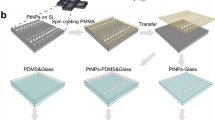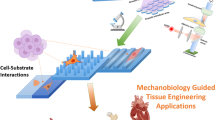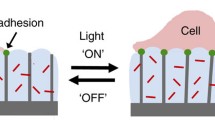Abstract
Rigidity sensing plays a fundamental role in multiple cell functions ranging from migration, to proliferation and differentiation (Engler et al., Cell 126:677–689, 2006; Lo et al., Biophys. J. 79:144–152, 2000; Wells, Hepatology 47:1394–1400, 2008; Zoldan et al., Biomaterials 32:9612–9621, 2011). During migration, single cells have been reported to preferentially move toward more rigid regions of a substrate in a process termed durotaxis. Durotaxis could contribute to cell migration in wound healing and gastrulation, where local gradients in tissue rigidity have been described. Despite the potential importance of this phenomenon to physiology and disease, it remains unclear how rigidity guides these behaviors and the underlying cellular and molecular mechanisms. To investigate the functional role of subcellular distribution and dynamics of cellular traction forces during durotaxis, we developed a unique microfabrication strategy to generate elastomeric micropost arrays patterned with regions exhibiting two different rigidities juxtaposed next to each other. After initial cell attachment on the rigidity boundary of the micropost array, NIH 3T3 fibroblasts were observed to preferentially migrate toward the rigid region of the micropost array, indicative of durotaxis. Additionally, cells bridging two rigidities across the rigidity boundary on the micropost array developed stronger traction forces on the more rigid side of the substrate indistinguishable from forces generated by cells exclusively seeded on rigid regions of the micropost array. Together, our results highlighted the utility of step-rigidity micropost arrays to investigate the functional role of traction forces in rigidity sensing and durotaxis, suggesting that cells could sense substrate rigidity locally to induce an asymmetrical intracellular traction force distribution to contribute to durotaxis.




Similar content being viewed by others
References
Desai, R. A., L. Gao, S. Raghavan, W. F. Liu, and C. S. Chen. Cell polarity triggered by cell-cell adhesion via E-cadherin. J. Cell Sci. 122:905–911, 2009.
Discher, D. E., D. J. Mooney, and P. W. Zandstra. Growth factors, matrices, and forces combine and control stem cells. Science 324:1673–1677, 2009.
Dupin, I., E. Camand, and S. Etienne-Manneville. Classical cadherins control nucleus and centrosome position and cell polarity. J. Cell Biol. 185:779–786, 2009.
Engler, A. J., S. Sen, H. L. Sweeney, and D. E. Discher. Matrix elasticity directs stem cell lineage specification. Cell 126:677–689, 2006.
Fu, J., et al. Mechanical regulation of cell function with geometrically modulated elastomeric substrates. Nat. Methods 7:733–736, 2010.
Ghassemi, S., et al. Fabrication of elastomer pillar arrays with modulated stiffness for cellular force measurements. J. Vac. Sci. Technol. B 26:2549–2553, 2008.
Ghassemi, S., et al. Fabrication of elastomer pillar arrays with modulated stiffness for cellular force measurements. J. Vac. Sci. Technol. B 26:2549–2553, 2008.
Gilbert, P. M., et al. Substrate elasticity regulates skeletal muscle stem cell self-renewal in culture. Science 329:1078–1081, 2010.
Hoffecker, I. T., W-h Guo, and Y-l Wang. Assessing the spatial resolution of cellular rigidity sensing using a micropatterned hydrogel-photoresist composite. Lab. Chip 11:3538–3544, 2011. doi:10.1039/c1lc20504h.
Isenberg, B. C., P. A. DiMilla, M. Walker, S. Kim, and J. Y. Wong. Vascular smooth muscle cell durotaxis depends on substrate stiffness gradient strength. Biophys. J. 97:1313–1322, 2009.
Jiang, X., D. A. Bruzewicz, A. P. Wong, M. Piel, and G. M. Whitesides. Directing cell migration with asymmetric micropatterns. Proc. Natl Acad. Sci. U.S.A. 102:975–978, 2005. doi:10.1073/pnas.0408954102.
Liu, Z., et al. Mechanical tugging force regulates the size of cell-cell junctions. Proc. Natl Acad. Sci. U.S.A. 107:9944–9949, 2010.
Lo, C. M., H. B. Wang, M. Dembo, and Y. L. Wang. Cell movement is guided by the rigidity of the substrate. Biophys. J. 79:144–152, 2000.
Lo, C. M., et al. Nonmuscle myosin IIb is involved in the guidance of fibroblast migration. Mol. Biol. Cell 15:982–989, 2004.
Lopez, J. I., I. Kang, W. K. You, D. M. McDonald, and V. M. Weaver. In situ force mapping of mammary gland transformation. Integr. Biol. (Camb) 3:910–921, 2011.
Maruthamuthu, V., B. Sabass, U. S. Schwarz, and M. L. Gardel. Cell-ECM traction force modulates endogenous tension at cell-cell contacts. Proc. Natl Acad. Sci. U.S.A. 108:4708–4713, 2011.
Ng, M. R., A. Besser, G. Danuser, and J. S. Brugge. Substrate stiffness regulates cadherin-dependent collective migration through myosin-II contractility. J. Cell Biol. 199:545–563, 2012.
Plotnikov, S. V., A. M. Pasapera, B. Sabass, and C. M. waterman. force fluctuations within focal adhesions mediate ECM-rigidity sensing to guide directed cell migration. Cell 151:1513–1527 (2012).
Raab, M., et al. Crawling from soft to stiff matrix polarizes the cytoskeleton and phosphoregulates myosin-II heavy chain. J. Cell Biol. 199:669–683, 2012.
Saez, A., A. Buguin, P. Silberzan, and B. Ladoux. Is the mechanical activity of epithelial cells controlled by deformations or forces? Biophys. J. 89:L52–L54, 2005.
Sochol, R. D., A. T. Higa, R. R. R. Janairo, S. Li, and L. W. Lin. Unidirectional mechanical cellular stimuli via micropost array gradients. Soft Matter 7:4606–4609, 2011.
Sun, Y., C. S. Chen, and J. Fu. Forcing stem cells to behave: a biophysical perspective of the cellular microenvironment. Annu. Rev. Biophys. 41:519–542, 2012. doi:10.1146/annurev-biophys-042910-155306.
Sun, Y., L. T. Jiang, R. Okada, and J. Fu. UV-modulated substrate rigidity for multiscale study of mechanoresponsive cellular behaviors. Langmuir 28:10789–10796.
Tee, S. Y., J. Fu, C. S. Chen, and P. A. Janmey. Cell shape and substrate rigidity both regulate cell stiffness. Biophys. J. 100:L25–L27, 2011.
Théry, M., et al. Anisotropy of cell adhesive microenvironment governs cell internal organization and orientation of polarity. Proc. Natl Acad. Sci. U.S.A. 103:19771–19776, 2006. doi:10.1073/pnas.0609267103.
Trichet, L., et al. Evidence of a large-scale mechanosensing mechanism for cellular adaptation to substrate stiffness. Proc. Natl Acad. Sci. U.S.A. 109:6933–6938, 2012.
Vicente-Manzanares, M., K. Newell-Litwa, A. I. Bachir, L. A. Whitmore, and A. R. Horwitz. Myosin IIA/IIB restrict adhesive and protrusive signaling to generate front–back polarity in migrating cells. J. Cell Biol. 193:381–396, 2011. doi:10.1083/jcb.201012159.
Vincent, L. G., Y. S. Choi, B. Alonso-Latorre, J. C. del Álamo, and A. J. Engler. Mesenchymal stem cell durotaxis depends on substrate stiffness gradient strength. Biotechnol. J. 8:472–484, 2013. doi:10.1002/biot.201200205.
Wang, H.-B., M. Dembo, S. K. Hanks, and Y-l Wang. Focal adhesion kinase is involved in mechanosensing during fibroblast migration. Proc. Natl Acad. Sci. U.S.A. 98:11295–11300, 2001. doi:10.1073/pnas.201201198.
Weber, G. F., M. A. Bjerke, and D. W. DeSimone. A mechanoresponsive cadherin-keratin complex directs polarized protrusive behavior and collective cell migration. Dev. Cell 22:104–115, 2012.
Wells, R. G. The role of matrix stiffness in regulating cell behavior. Hepatology 47:1394–1400, 2008.
Weng, S., and J. Fu. Synergistic regulation of cell function by matrix rigidity and adhesive pattern. Biomaterials 32:9584–9593, 2011.
Yang, M. T., J. Fu, Y.-K. Wang, R. A. Desai, and C. S. Chen. Assaying stem cell mechanobiology on microfabricated elastomeric substrates with geometrically modulated rigidity. Nat. Protoc. 6:187–213, 2011.
Yang, M. T., N. J. Sniadecki, and C. S. Chen. Geometric considerations of micro- to nanoscale elastomeric post arrays to study cellular traction forces. Adv. Mater. 19:3119–3123, 2007.
Yeung, T., et al. Effects of substrate stiffness on cell morphology, cytoskeletal structure, and adhesion. Cell Motil. Cytoskelet. 60:24–34, 2005.
Zhou, J., H. Y. Kim, and L. A. Davidson. Actomyosin stiffens the vertebrate embryo during crucial stages of elongation and neural tube closure. Development 136:677–688, 2009.
Zoldan, J., et al. The influence of scaffold elasticity on germ layer specification of human embryonic stem cells. Biomaterials 32:9612–9621, 2011.
Acknowledgments
We acknowledge financial support from the National Institutes of Health (EB00262, HL73305, and GM74048), the Penn Institute for Regenerative Medicine, the Nano/Bio Interface Center, and the Center for Musculoskeletal Disorders of the University of Pennsylvania. J. F. was partially funded by the American Heart Association Postdoctoral Fellowship, and R. D. was supported by a National Science Foundation Fellowship. We thank Pan Mao for assistance in scanning electron microscopy. The M.I.T. Microsystems Technology Laboratories is acknowledged for support in cleanroom fabrication.
Author information
Authors and Affiliations
Corresponding authors
Additional information
Associate Editor Michael R. King oversaw the review of this article.
Mark T. Breckenridge and Ravi A. Desai contributed equally to this work.
Electronic supplementary material
Below is the link to the electronic supplementary material.
Supporting Figure 1. (a) Cross-sectional SEM images showing the negative Si master after the first DRIE step with a regular array of cylindrical, vertical holes of a uniform depth across the Si substrate (i). ii shows the negative Si master after the second photolithography where exposed photoresist on the Si wafer was completely dissolved but photoresist filling the cylindrical holes were remained in the holes. (b) Tilted top-view SEM images showing the negative step-rigidity Si master with different magnifications as indicated.
Rights and permissions
About this article
Cite this article
Breckenridge, M.T., Desai, R.A., Yang, M.T. et al. Substrates with Engineered Step Changes in Rigidity Induce Traction Force Polarity and Durotaxis. Cel. Mol. Bioeng. 7, 26–34 (2014). https://doi.org/10.1007/s12195-013-0307-6
Received:
Accepted:
Published:
Issue Date:
DOI: https://doi.org/10.1007/s12195-013-0307-6




